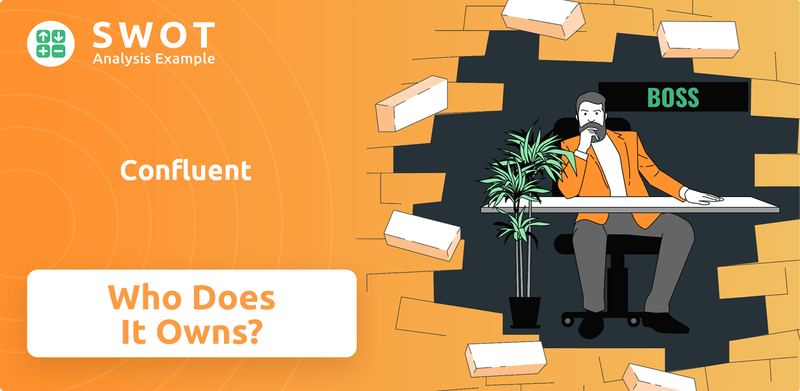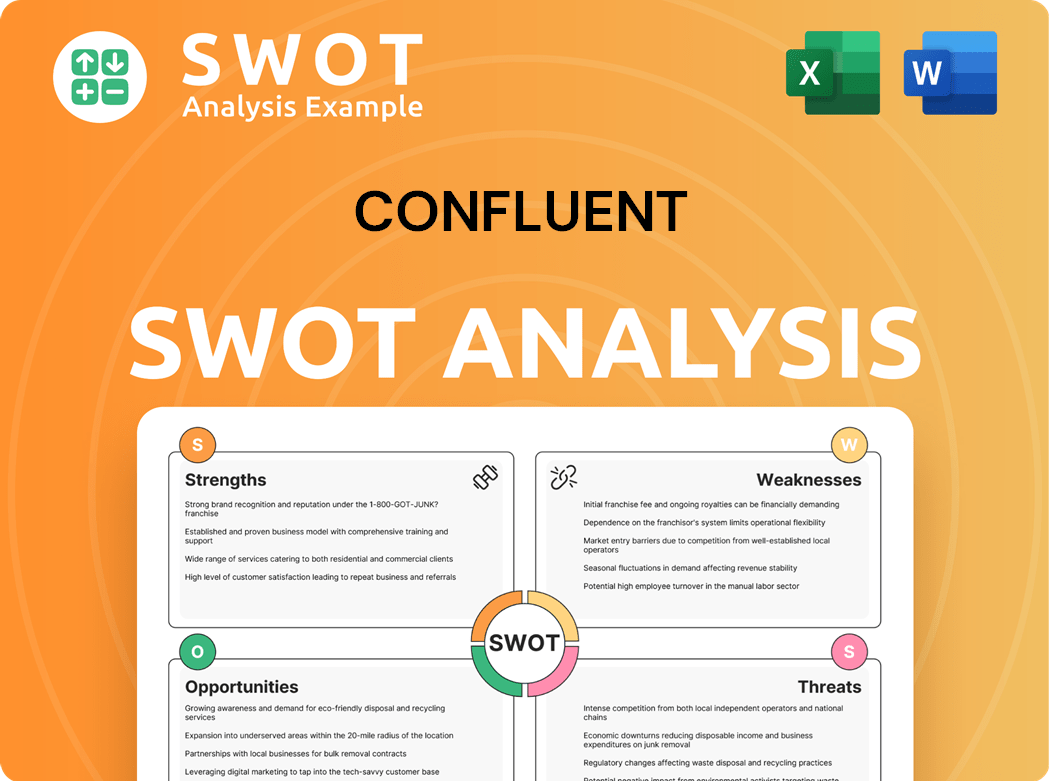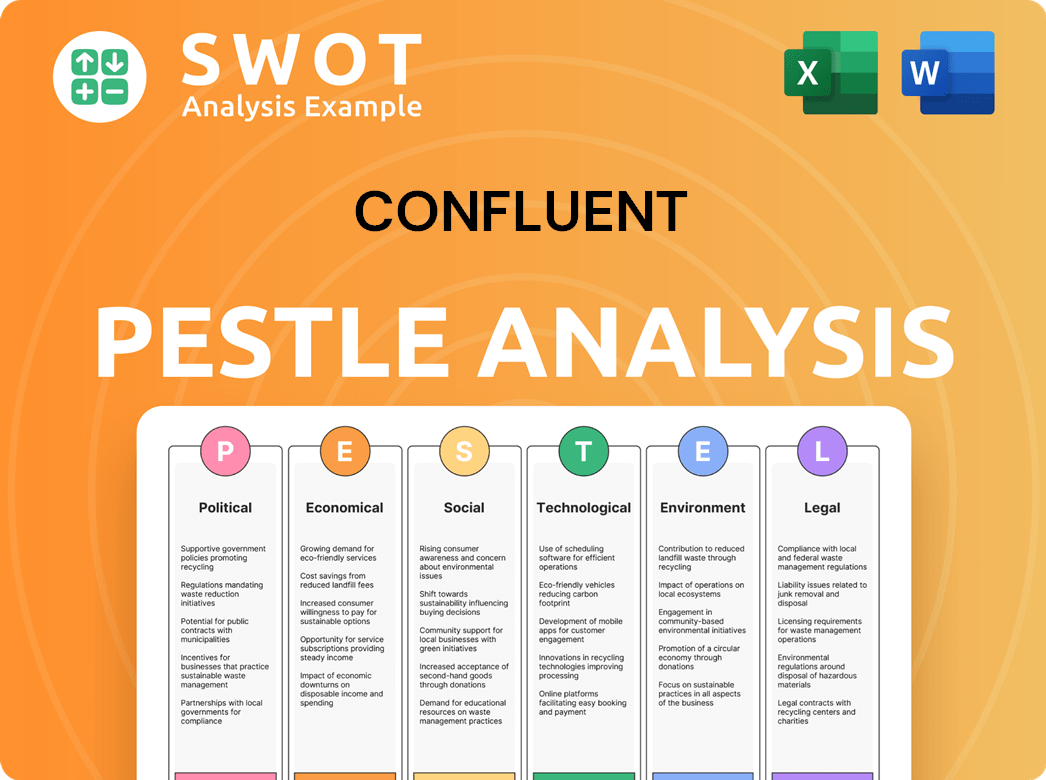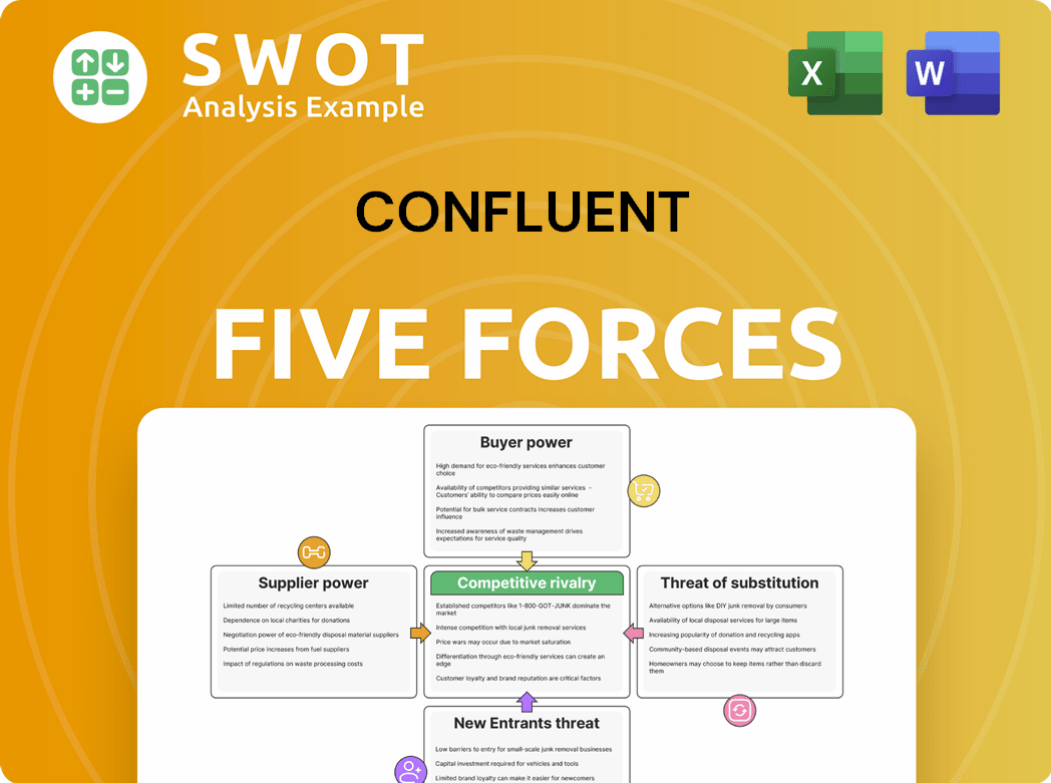Confluent Bundle
Who Really Owns Confluent?
Unraveling the Confluent SWOT Analysis is just the beginning; understanding its ownership is crucial. In the dynamic world of real-time data streaming, knowing who controls Confluent Inc. provides invaluable insights. This knowledge is essential for anyone seeking to understand the company's strategic direction and long-term prospects.

This exploration into Confluent company ownership will illuminate the forces shaping its future. From its roots with the founders of Apache Kafka to the influence of major Confluent investors, we'll dissect the ownership structure. Discover how the evolution of Confluent stock and its public listing has impacted its governance and strategic decision-making. Understanding the key players is paramount for anyone interested in the real-time data landscape.
Who Founded Confluent?
The story of Confluent Inc. began in 2014, born from the minds of three former LinkedIn engineers: Jay Kreps, Neha Narkhede, and Jun Rao. These individuals were the original creators of Apache Kafka, a distributed streaming platform. Their vision was to build a commercial platform based on Kafka, leading to the formation of Confluent company.
While the precise initial equity distribution among the founders isn't publicly available, it's common for co-founders to have significant, though not always equal, stakes. These initial shares are usually subject to vesting schedules. These schedules are designed to keep the founders committed to the company's long-term success by gradually releasing shares over several years.
Early financial backing was crucial for Confluent ownership. Benchmark and Lightspeed Venture Partners provided the initial seed round investment of $6.9 million. Further funding rounds, like the Series A round led by Benchmark, which brought in $24 million with continued participation from Lightspeed Venture Partners, shaped the Confluent company ownership structure.
Jay Kreps, Neha Narkhede, and Jun Rao, the founders, played key roles in the company's early development.
The seed round raised $6.9 million from Benchmark and Lightspeed Venture Partners.
Benchmark led the Series A round, investing $24 million, with Lightspeed Venture Partners also participating.
Founders' shares are typically subject to vesting schedules to ensure long-term commitment.
Early investors received significant equity stakes, providing capital and often board representation.
The founders' expertise in Apache Kafka was central to attracting early investment.
The early investors, in exchange for their capital, acquired significant equity stakes. This funding was essential for product development and market expansion. While specific details about buy-sell clauses or early founder exits are not widely publicized, such agreements are standard in venture-backed startups. The founders' vision for a commercial Kafka platform was key in attracting these early investors. To understand the market, you can explore the Target Market of Confluent.
Confluent SWOT Analysis
- Complete SWOT Breakdown
- Fully Customizable
- Editable in Excel & Word
- Professional Formatting
- Investor-Ready Format

How Has Confluent’s Ownership Changed Over Time?
The ownership structure of Confluent, or Confluent Inc., has undergone a significant transformation since its inception. Initially a privately held startup, the company's ownership was concentrated among its founders and early venture capital investors. This structure evolved dramatically with the initial public offering (IPO) on June 24, 2021. The IPO, which priced shares at $36.00, raised approximately $828 million, marking a pivotal moment in the company's history and broadening its shareholder base to include public investors.
The IPO was a crucial step in the evolution of Confluent ownership, shifting from a primarily private structure to a public one. This transition introduced a more diverse group of shareholders, including institutional investors and individual shareholders. The influx of capital from the IPO provided resources for growth and expansion, influencing the company's strategic direction and operational capabilities. The IPO also increased the company's visibility and market presence, attracting a wider range of investors and partners.
| Event | Date | Impact on Ownership |
|---|---|---|
| Founding of Confluent | 2014 | Initial ownership concentrated among founders and early investors. |
| Series A Funding | 2015 | Venture capital firms acquire significant stakes. |
| Initial Public Offering (IPO) | June 24, 2021 | Diversification of ownership to include public shareholders; founders' and VC stakes diluted. |
As of early 2025, Confluent investors include a mix of institutional investors, mutual funds, and individual insiders. Institutional ownership is a prominent feature of the Confluent company. For example, The Vanguard Group, Inc. and BlackRock, Inc. are among the largest institutional shareholders, holding significant percentages of the outstanding shares. These large institutional holdings can influence company strategy through their voting power. Jay Kreps, as CEO, remains a key insider with a substantial ownership stake. The shift to a more dispersed, institutional-heavy shareholder base impacts governance by incorporating a wider range of investor perspectives.
The ownership of Confluent has evolved significantly since its IPO in 2021. The current structure includes a mix of institutional investors, mutual funds, and individual insiders.
- Institutional investors such as The Vanguard Group, Inc. and BlackRock, Inc. hold significant shares.
- Founders, including Jay Kreps, maintain substantial ownership and influence.
- The shift to a public company has dispersed ownership, bringing in diverse investor perspectives.
- Understanding the ownership structure is crucial for assessing the company's governance and strategic direction.
Confluent PESTLE Analysis
- Covers All 6 PESTLE Categories
- No Research Needed – Save Hours of Work
- Built by Experts, Trusted by Consultants
- Instant Download, Ready to Use
- 100% Editable, Fully Customizable

Who Sits on Confluent’s Board?
The current board of directors at Confluent Inc. reflects a blend of founder representation, major shareholder interests, and independent expertise. As of early 2025, Jay Kreps, co-founder and CEO, serves on the board, providing a crucial founder's perspective. Other board members typically include representatives from significant venture capital firms that invested early in the company, although their direct board seats might change as their ownership percentages evolve post-IPO. The board also includes independent directors who bring diverse industry experience and governance oversight. Understanding the Brief History of Confluent can provide additional context to the company's evolution and leadership.
The board's composition aims to balance insider knowledge with independent oversight, a common practice among publicly traded companies. The presence of independent directors is crucial for ensuring that the board can provide objective guidance and oversight of management. The board's structure is designed to support the company's strategic direction and ensure accountability.
| Board Member | Role | Affiliation |
|---|---|---|
| Jay Kreps | Co-founder, CEO | Confluent |
| Representative | Board Member | Venture Capital Firm |
| Independent Director | Board Member | Various |
Confluent operates with a one-share-one-vote structure for its common stock, a standard practice for many public companies. This means each share of common stock generally entitles its holder to one vote on matters submitted to a vote of stockholders. While there are no publicly disclosed dual-class shares or special voting rights that would grant outsized control to specific individuals or entities, the collective voting power of large institutional investors and the continued influence of the founders as significant shareholders can shape decision-making. The company's governance structure appears aligned with standard public company practices, with the board overseeing strategic direction and management.
The board of directors at Confluent includes founder representation, venture capital representatives, and independent directors.
- The company uses a one-share-one-vote structure.
- Major shareholders and institutional investors have significant voting power.
- The board oversees strategic direction and management.
- The company's governance structure is aligned with standard public company practices.
Confluent Business Model Canvas
- Complete 9-Block Business Model Canvas
- Effortlessly Communicate Your Business Strategy
- Investor-Ready BMC Format
- 100% Editable and Customizable
- Clear and Structured Layout

What Recent Changes Have Shaped Confluent’s Ownership Landscape?
Over the past few years, the ownership profile of Confluent Inc. has evolved significantly, primarily due to its transition to a publicly traded company. Following its IPO in June 2021, Confluent's shares became accessible to a broader range of investors, leading to a rise in institutional ownership. This shift is typical for established tech companies as large institutional investors seek to capitalize on growth opportunities within the software and data sectors. As of early 2024, data indicates a continued trend of institutional investment, reflecting confidence in Confluent's market position and growth potential.
The company's leadership, with Jay Kreps as CEO, has remained consistent, providing stability in the ownership dynamics. While specific share buybacks or secondary offerings have not been widely announced in early 2025, these activities are common strategies for managing capital and shareholder value. The ongoing focus on expanding its platform and market reach has the potential to attract new strategic investors or partnerships, indirectly influencing the ownership landscape. Public statements from Confluent and analysts typically emphasize growth projections and market opportunities, which are crucial for attracting and retaining investors in the real-time data streaming market.
The company's performance and strategic announcements, such as new product features or significant customer wins, influence investor sentiment and, consequently, the trading of its shares. Confluent's commitment to the Apache Kafka ecosystem and real-time data streaming positions it within a growing market, influencing its long-term ownership trends. The company's market capitalization and stock performance are key indicators of investor confidence and ownership distribution. As of late 2024, Confluent's market capitalization reflects its position in the data streaming market, influencing the views of Confluent investors.
| Metric | Value (as of Late 2024) | Source |
|---|---|---|
| Institutional Ownership | Approximately 60-70% | Financial Data Providers |
| Market Capitalization | Varies, approximately $7-9 billion | Financial News Outlets |
| Employee Count | Approximately 3,000+ | Company Reports |
Institutional ownership has increased since the IPO, reflecting confidence in the company's growth. The market capitalization fluctuates but indicates a strong position in the real-time data streaming market. Leadership continuity under Jay Kreps provides stability for Confluent company.
The IPO in June 2021 opened up Confluent stock to a wider investor base. Increased liquidity and capital access have supported the company's expansion. Public markets provide more opportunities for capital raising and strategic partnerships.
Continued expansion of the platform and market reach will attract new investors. Strategic announcements and product launches will influence investor sentiment. The Apache Kafka ecosystem will continue to shape long-term ownership trends.
The company's ownership structure is primarily influenced by institutional investors. The founders and early investors still hold significant stakes. The company's financial performance and reports are key factors.
Confluent Porter's Five Forces Analysis
- Covers All 5 Competitive Forces in Detail
- Structured for Consultants, Students, and Founders
- 100% Editable in Microsoft Word & Excel
- Instant Digital Download – Use Immediately
- Compatible with Mac & PC – Fully Unlocked

Related Blogs
- What are Mission Vision & Core Values of Confluent Company?
- What is Competitive Landscape of Confluent Company?
- What is Growth Strategy and Future Prospects of Confluent Company?
- How Does Confluent Company Work?
- What is Sales and Marketing Strategy of Confluent Company?
- What is Brief History of Confluent Company?
- What is Customer Demographics and Target Market of Confluent Company?
Disclaimer
All information, articles, and product details provided on this website are for general informational and educational purposes only. We do not claim any ownership over, nor do we intend to infringe upon, any trademarks, copyrights, logos, brand names, or other intellectual property mentioned or depicted on this site. Such intellectual property remains the property of its respective owners, and any references here are made solely for identification or informational purposes, without implying any affiliation, endorsement, or partnership.
We make no representations or warranties, express or implied, regarding the accuracy, completeness, or suitability of any content or products presented. Nothing on this website should be construed as legal, tax, investment, financial, medical, or other professional advice. In addition, no part of this site—including articles or product references—constitutes a solicitation, recommendation, endorsement, advertisement, or offer to buy or sell any securities, franchises, or other financial instruments, particularly in jurisdictions where such activity would be unlawful.
All content is of a general nature and may not address the specific circumstances of any individual or entity. It is not a substitute for professional advice or services. Any actions you take based on the information provided here are strictly at your own risk. You accept full responsibility for any decisions or outcomes arising from your use of this website and agree to release us from any liability in connection with your use of, or reliance upon, the content or products found herein.